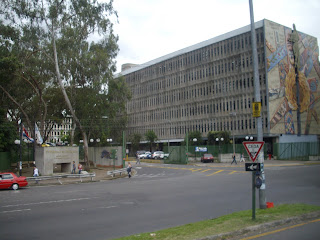This summer, I had the opportunity to go to Costa Rica. For an entire month I was immersed in a culture and a language that is, at times, very different than my own. I lived with a host family for the whole month so I was able to not only see, but experience what it is like to live like a typical Tican (Costa Rican). My “Mama Tica,” as I called her, fixed breakfast and supper for me every morning and evening so I was able to try different types of Costa Rican food.
Everyday, to get to school we had to take the bus, which was a new experience for me because I have never had to use public transportation on a regular basis before. I learned, though, that public transportation is the best (and safest) way to get around the city. My class was at the University of Costa Rica.

Three times during our trip, after classes, MLSA took us to different places around San Jose. The first week we went to the National History Museum, which is housed in what used to be the armory.
 The National History Museum
The National History MuseumWe got to walk around and see different artifacts and pictures from Costa Rica’s history. One of the most interesting parts, for me, was the huge stones spheres that have been found in Costa Rica. No one knows where they came from or how they were made, but they have been found all over the country.

The next week, MLSA took us to what used to be the capital of Costa Rica and is one of the oldest cities; Cartago. There are two main sights to see in Cartago. The first sight is ruins of an ancient church never built. The story goes that whenever they tried to build the church, something made the structure collapse.

The other sight is an old basilica. Every year, right around the time we left Costa Rica, people from all over the country and neighboring countries will walk to Cartago to participate in an old tradition, that many believe will provide healing, but only if you walk.

The third week, we went to the National Theater. We did not get to see a play because they were getting ready to open back up, but we got to walk around the theater and we had a tour guide to tell us about the history of the building.
Apart from these trips, MLSA offered us the opportunities to go visit the La Paz volcano one weekend and to go on a cruise to the Tortuga Islands the next weekend. Both of these excursions allowed us to, not only experience, but fully immerse ourselves in the beauty of Costa Rica.
My professor (Dr. Catalina Adams), who is from Costa Rica and went with us on this trip, took us to the National Art Museum one afternoon where we got to see Costa Rica’s history in and through art.


My favorite trip that we went on with Dr. Adams was the weekend we spent at Playa Hermosa, Playa Jacó and the Tu Ru Bari Tropical Park. We drove to Playa Hermosa in the morning and spent most of the day there. That evening we went to Playa Jacó. We spent the night in some cabins and the next day we drove to the tropical park. There we got to go on a canopy tour. They hooked us up to ziplines and let us fly through and above the trees in the jungle.

Probably, the quirkiest piece of culture I experienced was the CowParade. Artists from all over the country created over 130 cow statues. Each cow represents a different aspect of Costa Rican life and culture. Some were as simple as a cow statue with a mural type painting on it while others were more elaborate like a cow being hung in the air between two trees to look as though it were on a canopy tour.


After spending a month in Costa Rica, I experienced and learned so much about the culture, history and every day life of the country. If I ever get a chance to go back, I will and I would encourage anyone else to visit Costa Rica as well.
 The Winthrop kids after our canopy tour.
The Winthrop kids after our canopy tour.
No comments:
Post a Comment